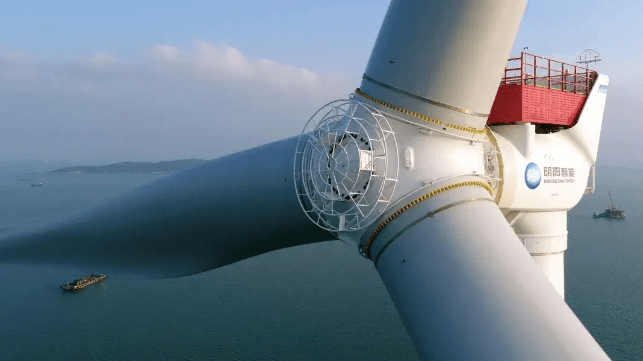Why is Offshore Wind Soaring in China When it's Struggling in the West?

While the offshore wind industry is struggling with inflation and high interest rates in the West, China's market is soaring. To learn why, TME recently spoke with Joseph Webster, senior fellow at the Atlantic Council's Global Energy Center and an expert on China's offshore wind sector.
What are your thoughts on the near term outlook for the Chinese offshore wind market?
China’s domestic offshore wind market enjoys significant fundamental support, owing to the increasing commercial maturity of the technology and China’s political economy.
Chinese coastal provinces are incentivized to construct offshore wind capacity due to relatively high electricity prices and the technology’s semi-baseload generation profile. Each province also has minimum non-hydro renewables consumption targets, while accessing offshore wind does not require inter-provincial electricity transfers, which are highly fraught within China. While the central government closed the feed-in-tariff’s fiscal support in 2021, provincial authorities are often stepping up with their own direct and indirect fiscal support.
Offshore wind is already highly commercially viable across much of China, especially after governmental incentives, while Chinese wind sector actors are increasingly accessing economies of scale.
China’s strengths in steelmaking and shipbuilding, especially of wind turbine installation vessels, also offer it enormous structural advantages in the offshore wind sector.
Finally, China’s real estate downturn is softening the price of domestic steel and containing costs for its OEMs and developers.
Has the Chinese market felt the same challenges as the rest of the world - that is, high interest rates and soaring costs?
While the US and Europe are experiencing a prolonged period of elevated inflation rates, the Chinese market is actually suffering from a different problem: deflation. According to Reuters, China’s consumer price index is down 0.2 percent year-over-year; its producer price index is down by 2.6 percent. China’s steel prices may even fall in 2024, according to some analysts, which could lower costs for its turbine OEMs and developers.
State-owned enterprises typically receive highly preferential treatment, including via interest rate subsidization. According to a CSIS analysis, “Even after accounting for size, industry, and type of bonds, SOEs enjoy borrowing costs that are at least 1 percentage point lower than private firms.” While not all Chinese wind sector actors are state-owned, many enjoy access to preferential interest rates.
Furthermore, China’s “financial repression” model limits interest rates and incentivizes capital expenditures.
In sum, while comparing real interest rates and borrowing costs across the US/Europe and China is difficult, Chinese firms appear to enjoy access to lower real interest rates.
What should we be watching for going forward?
There are three areas worth watching closely: China’s installation of large or even ultra-large turbines, floating offshore wind, and the continued consolidation of the sector. China’s advantages in steel and shipbuilding may enable it to build vessels capable of installing ultra-large turbines commercially and at scale. Additionally, floating offshore wind could become more commercially viable in China.
Finally, the number of Chinese OEMs may continue to decline, which would likely enable greater efficiencies and economies of scale, enhancing the sector’s competitiveness. These trends may take several years to play out, while the economics of floating offshore wind remain uncertain.
Do you see opportunities for Chinese offshore turbines in the West - for example, UK and Norway, where Mingyang is preparing to bid?
There is a tension between the UK and Norway’s economic and environmental interests, on the one hand, and their willingness to incorporate Chinese participation in critical infrastructure.
While Mingyang’s turbines might reduce initial costs, incorporating Chinese equipment on their electricity grids would prove risky for the UK and Norway. Furthermore, emplacing Chinese turbines and sensors in sensitive areas could inhibit NATO military operations, especially for ultra-sensitive submarines.
Mingyang may ultimately localize production in Europe, especially in non-EU states that have weaker ties to US and EU OEMs, but NATO’s security concerns will constrain Chinese OEMs’ ambitions. Consequently, while the UK and Norway may be relatively receptive to Mingyang and other Chinese wind actors, there will be limits to the integration of Chinese companies into their offshore wind sectors. It’s worth remembering that the UK government removed China General Nuclear from the Sizewell nuclear project in Nov 2022 amid fears over Beijing’s involvement in critical infrastructure projects.
European imports of Chinese turbines will also be constrained by the unfavorable economics of shipping wind turbines internationally over great distances. Rather, European offshore wind actors are more concerned about a flood of Chinese component and sub-components entering the market. The risk of a surge in Chinese wind exports to the U.S. is much lower, owing to the bipartisan opposition to Beijing in Washington, D.C.
Chinese offshore wind turbine makers may seek to invest across the West, especially in Europe, and produce turbines locally, although these investments would carry considerable political, economic, and security risks and would face significant scrutiny. - TME
